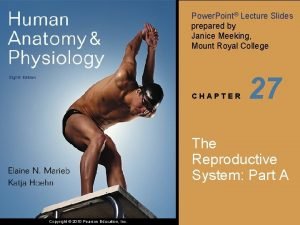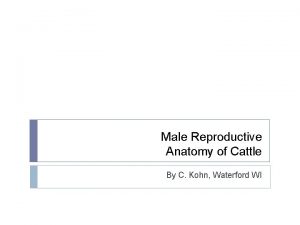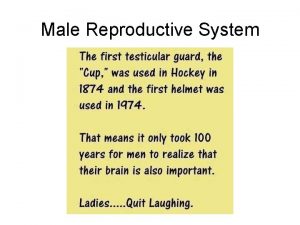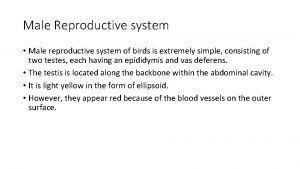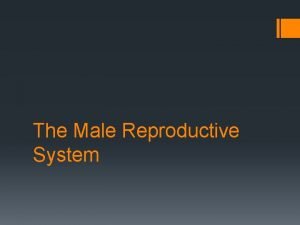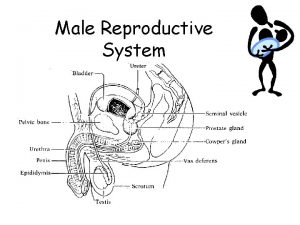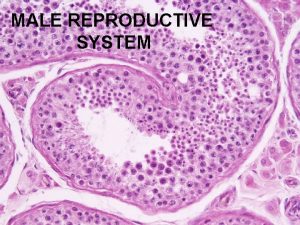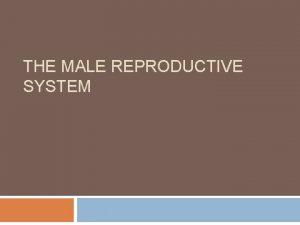Anatomy of the Male Reproductive System Anatomy of















- Slides: 15

Anatomy of the Male Reproductive System

Anatomy of the Male Reproductive System

Internal and external anatomy of the Testis • Pathway for Sperm 1. Seminiferous tubule 2. Straight tubule 3. Rete testis 4. Efferent duct 5. Ductus Epididymis 6. Ductus deferens

Histology of the Testis and Spermatogenesis

Steps of Spermatogenesis • Spermatogonia: diploid stem cells that undergo mitosis to give rise to daughter cells that either become primary spermatocytes or remain as spermatogonia • Primary spermatocytes: diploid cells that undergo meiosis 1 • Secondary spermtocytes: haploid cells formed from meiosis 1

Steps of Spermatogenesis • Spermatids: Cells resulting from meiosis II, become spermatozoa

Hormonal control of the Male Reproductive System • Hypothalamus releases Gn. RH • Gn. RH stimulates the Gonadotrophs of the adenohypophysis to release FSH and LH • FSH stimulates Sertoli cells to secrete Androgenbinding protein (ABP) and stimulates spermatogenesis.

Hormonal control of the Male Reproductive System • LH stimulates the Leydig cells to secrete testosterone • Inhibin secreted by Sertoli cells controls the release of FSH by gonadotrophs

Organs involved in the Production of Semen • Seminal Fluid: Volume of a typical ejaculation is 2. 5 – 5. 0 ml with a sperm count of 50 – 150 million sperm (under 20 million sperm is considered infertile), fluid is slightly alkaline at p. H 7. 2 – 7. 7. • Seminal Vesicles: Produce 60% of the volume of seminal fluid; SV’s produce an alkaline viscous fluid that contains: fructose, prostaglandins, and clotting proteins

Organs involved in the Production of Semen • Prostate Gland: Produce 25% of the volume of seminal fluid; This fluid is a milky, slightly acidic fluid that contains citric acid (for ATP production), acid phosphatase along with several other enzymes ( prostate-specific antigen PSA, pepsinogen, and lysozyme • Bulbo-urethral gland: produces alkaline mucus that help lubricate the urethra and the head of the penis • Ampulla of ductus deferens: releases up to 150 million sperm cells

The Male Sexual Response • Arousal: various erotic thoughts and physical stimulation triggers parasympathetic reflexes that cause an erection. • Erection: occurs when neurons release Nitric oxide at their synaptic endings. • NO causes smooth muscles of the penile arteries to relax, vessels dilate, blood flow to the erectile tissue increases. The vascular channels engorge with blood, resulting pressure causes the penis to become stiff.

The Male Sexual Response • During arousal increases in heart rate, blood pressure, skeletal muscle tone, and hyperventilation occur • Bulbourethral glands: continued stimulation causes the release of mucus from these glands, this mucus lubricates the penile urethra and the glans penis. These secretions can carry sperm.

The Male Sexual Response • Plateau stage: Changes that begin during arousal are sustained at an intense level, head of the penis increases in diameter and the testes swell due to vasocongestion. Toward the end of the plateau stage, emission occurs. Emission: sympathetic stimulation causes peristaltic contractions of the ampulla that push fluid and spermatozoa into the ejaculatory duct, peristaltic contractions of the seminal vesicles and the prostate push seminal fluid in the ejaculatory duct and the penile urethra. Contraction of the internal urethral sphincter and the bladder occurs.

The Male Sexual Response • Ejaculation: Sympathetic stimulation of the ischiocavernosus and bulbospongiosus muscles causes powerful rhythmic contractions that push the semen out of the penile urethra. Orgasm; intensely pleasurable sensations associated with ejaculation. Other physiological changes include pronounced increase in heart rate and blood pressure.

The Male Sexual Response • Resolution: Sense of profound relaxation- genital tissues, heart rate, blood pressure, breathing, and muscle tone return to normal. During early period of resolution, males enter a refractory period during which a second ejaculation and orgasm are physiologically impossible.
 Prostate anatomy
Prostate anatomy Function of vagina
Function of vagina Function of reproductive system
Function of reproductive system Female testes
Female testes Exercise 42 review male reproductive system
Exercise 42 review male reproductive system Corpus albicans vs corpus luteum
Corpus albicans vs corpus luteum Diagram of male reproductive organ
Diagram of male reproductive organ Female and male reproductive system
Female and male reproductive system Pearson education
Pearson education Luteinizing hormone in male reproductive system
Luteinizing hormone in male reproductive system Male reproductive system in plants
Male reproductive system in plants Art-labeling activity: the male reproductive system, part 1
Art-labeling activity: the male reproductive system, part 1 Male reproductive system information
Male reproductive system information Where is sperm located
Where is sperm located Male cow reproductive system diagram
Male cow reproductive system diagram Male reproductive system plants
Male reproductive system plants











